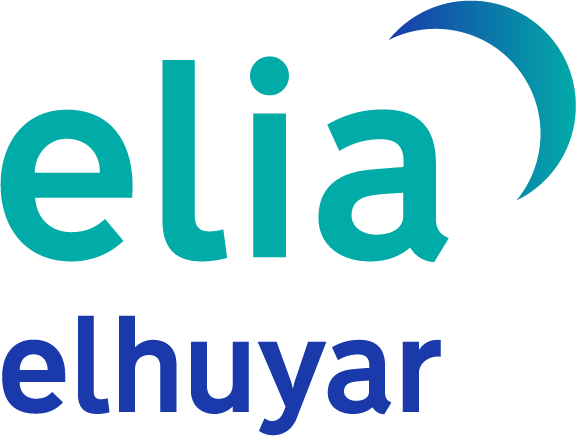The article will start with numbers and a review of the percentages that have changed in the international media ecosystem, a report of the numerical sequences chosen to be expressed in letter. The year 2020 has set a special scenario that could be summed up in three keys and five trends, but above all that which has picked up the digital culture square. Here and there. Because in us things are similar. Living water. In the era of algorithms, in the year of accelerations and cracks, at a time when everything is hyper-personalized, the lines that come are also a hyper-subjective selection, which have been read and left here to contrast in interaction with your hypersubjectivities. Alphabet soup looking for a ‘reflection’ than an ‘island’.
AMENDED NUMBERS AND PERCENTAGES
You only have to look at what happens in 60 seconds on the Internet to see the fall of the media ecosystem: 347,000 stories are created every minute, 500 hours of video are uploaded to Youtube, 147,000 photos are shared on Facebook, 41.6 million messages are sent via Whatsapp… and thousands of jokes, online meetings and connections, shopping and audiovisual (Statista, 2020).

The media are in this context. The Internet is not just media. Therefore, in addition to offering its own supports, it is necessary to filter by external supports so that the information flows across the network.
Also, if something has meant 2020, it has been the acceleration of digitalisation. International studies that observe the online behavior of users have again indicated what we live in our daily life.
For example, the Reuters Institute’s Digital News Report 2020 study collects data from 40 markets across six continents (from the collection of pandemic data prior to the explosion, on the one hand, and therefore historical trends; and, on the other hand, parts of the survey were again asked early in April in six countries – Germany, Argentina, South Korea, Spain, the United States and Kingdom).
The goals are: news consumption has increased worldwide as a result of the coronavirus crisis, and television and online media have grown the most. The use of social media also increased considerably in most countries. According to the rapporteurs, 2020 has been a year of acceleration for the transformation into a fully digital future.
With regard to trust, in April 2020, citizens’ confidence in the media was double that in social networks, video platforms or messaging services.
On the other hand, the data collected in January highlighted the trends of widespread concern about misinformation—more than half of the sample expressed concern about the differentiation of real and fake news—46% with confidence in the consumed news, notable increases in payment news in several countries (e.g., the US increased by 20%, four more points than in the previous edition, and in Norway, 42% of the main news brands.
In all countries, 28% of the population begins their dose of information on a website or app, while those between the ages of 18 and 24 (the Gen Z calls) are more than twice as likely to choose social networks as access to news. In this direction, those who use Instagram as a source of information from the network have doubled in all age groups, with this network expected to exceed Twitter the following year. To cope with this move to other platforms, the media has sought to find more direct connections with users, such as email or mobile alerts.
Another notable phenomenon is podcasts, whose proportion of podcast users has increased considerably in the last year.
In two words, we go digital. Online news has surpassed television as the most widely used source of information, as shown by data from the last nine years of the Reuters reports in different countries analyzed. Similarly, paper printed newspapers have been declining and social media has been moving towards stabilisation after a sharp rise. In 2020, the coronavirus crisis has substantially changed this picture, but probably temporarily: television information has increased and the trend has spread to reliable sources of information, including public media. Likewise, social networks have also grown significantly (five points, along with television), to which people turned to seek and share news, along with television and online media. Logically, the confinements impaired paper expansion and, above all, online consumption was imposed in all countries:

Trends vary by age, as happened at the first appearance of coronavirus. The following graph from the United Kingdom shows the support in which the information was used as a source of information for each age group (35 years below / 35 to 55 years / 55 years up).
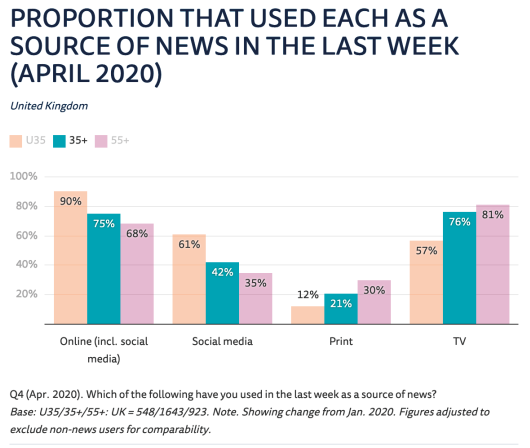
The pre-eminence of the online option is undeniable in all age groups, and although it is more notable in younger people, the force of social networks in general is evident. What photograph would a data collection from Euskal Herria show?
Messaging apps are also increasingly being used to learn, at least one in four citizens acknowledges this: 24% answered the question “Have you used Whatsapp for news?” in six countries in April, six more points than in January.
Once the information has conquered all the supports, the following graph shows the distribution of concern about misinformation for the supports:
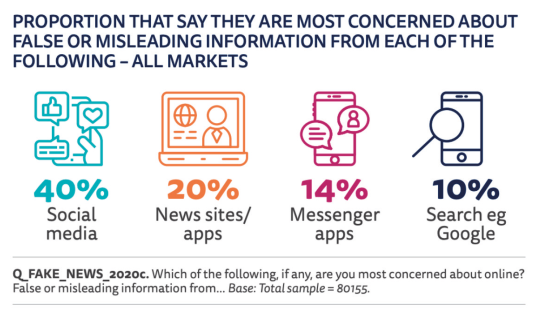
The graph corroborates the above: 20% of the population is concerned about the suitability of information in the media, while the data show a higher level of trust towards the media than towards social networks.
According to the Reuters Institute report, the impact of the COVID-19 crisis on the media industry is still early, but they note that 2020 will be a catalyst for reducing spending and changing business models. Three scenarios have been foreseen, the growth of digital subscribers, the loss of access to advertising, in some cases in decline, and the restrictions: less copies, less personal, stop printing. They also say that the focus will be included in the online payment model: membership, donations or micro payments. We have seen communication projects that this year have started to collect content or have reinforced their walls. Support for the project, reduction of the offer of free content, special promotions, etc. have been cited as grounds for accession and extensive campaigns have been carried out in favour of the payment of trustworthy, rigorous and rigorous journalism. In the same context, the information held behind the payment walls has been opened free of charge for the benefit of public health.
In one way or another, the population has consumed more news than ever before in 2020. To learn about the growth that has occurred online in the digital media ecosystem, it is convenient to observe which digital sources the information has been made in: 28% of the population opts for the web or application of media to start their digital media diet, 26% use social networks and 25% use search engines.
Conversely, the order in which digital sources are found throughout the population is quite similar, in numerical terms, to the significant differences observed only between 16 and 24 years: direct traffic only 16% (12 points below average), social networks 38% (12 points above average) and search engines 25% (compared to average). The following graph shows the differences:


Therefore, as age decreases, the relationship of the user with the consumption of information is not so much with the brand, the media, but is included in the equation a mediator (a platform of a social network or another). Therefore, if we cannot attract these groups of young people to direct connection, we will have to think carefully how to build audiences through third-party platforms (today via Facebook, Instagram and Twitter).
Aggregate news that may be useful, in general, is not remembered by people when conducting surveys, let alone by the consumption of alerts or warnings on the mobile.
Faced with the growing power of platforms, the media seek direct connections with audiences via e-mail: postal newsletters and mobile communications, among others. They use email as a tool to capture potential subscribers, as well as to return users more frequently to media portals. The recovery of the newsletter and/or newsletter aims to guide users in the daily information. However, among these strategies, emails are generally more popular among the majority and young people prefer mobile notifications.
Finally, this international trend review should mention podcasts and their consumption. Podcasts, both informative and specific, are produced thinking about displacements and/or domestic consumption. Both are booming: Podcasts consumption in general has increased by 31% internationally (three points higher than last year) and the average listener consumes at least one podcast per month. They"re usually younger listeners. Although the most common podcasts are the ones that work on news and political issues, the youngest ones are strong lifestyle programs.

As observed in the graph above, podcasts vs radio are a phenomenon mainly associated with age. In the United Kingdom, half of all podcasts are heard by children under the age of 35 — although they only represent a third of the sample. Conversely, those who regularly listen to newsletters and traditional radio news programs are over 50 years old. Do we Basques have a similar trend?
THREE KEYS AND FIVE TRENDS
In the same direction as the report published by the Institute Reuters, Comscore’s “Global Perspectives: digital and CTV trends to watch in 2021” prospective document also speaks. In this sense, the study that contemplates online behaviors in 2020 and their possibilities for 2021 starts as follows:
“Sometimes history accelerates. The disruption caused by COVID-19 has led people to redesign their way of working, socializing and organizing. Social and individual priorities are being reviewed and rethought from scratch. The long-term consequences of all this will not be known temporarily, but things are not very likely to return as they were before the pandemic” (Comscore, 2020).
This poses a challenge for brands and also for advertisers, to predict and adapt to changes in user behaviour.
The global pandemic brought a number of changes in media consumption, and users around the world generally increased their online time. In order to help calibrate advertisers’ plans, the Comscore agency report identifies five trends summarized in three keys:
- The growth of connected television (or CTV) allows the dissemination of digital advertising also on television, increasing the possibilities.
- Everything can change very quickly and the times of change are being shortened. It should focus on continuous experimentation, measurement, learning and interaction.
- The use of technology platforms is becoming more specialized. Concrete actions in some devices and others. The desktop computer is a mobile work and relaxation tool, so in addition to adjusting campaigns to the audience profile, they can also be defined according to context, such as the platform.
FIRST TREND: TOWARDS A SOCIETY ALWAYS CONNECTED
If, when it comes to looking at the size of the digital markets, we compare those that connected online in September 2019 to those that connected in September 2020, the first conclusion is that in almost all countries the proportion of connected citizens has increased.
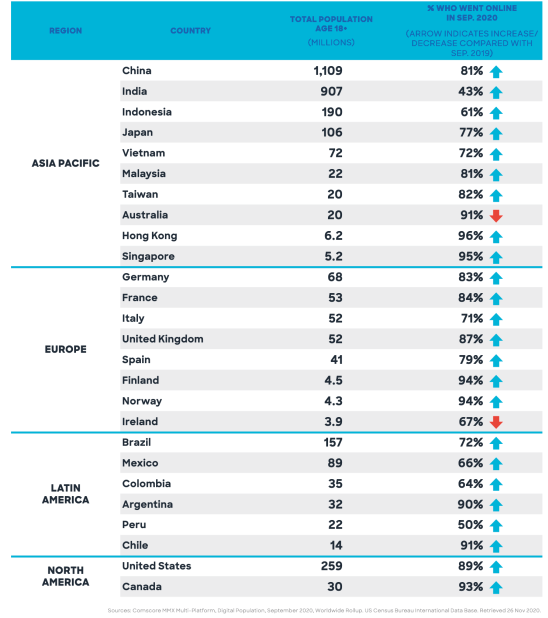
The older population that connected online, that is, the digital population over 18, has grown in the last year. In addition, in 17 of the 26 countries on the list this percentage exceeds 75 per cent.
Yet total digitalisation is still a long way off. In the absence of the whole of Africa in the study of the Comscore agency, regardless of the country in which it is located, digitalisation is correlated, among other things, with urbanization, and this process is still ongoing. According to the rapporteurs, the countries with the largest urbanization such as Singapore or Hong Kong are the ones with the most internet activity, as well as technology upgrading, improvement such as 5Ga and infrastructure investments. Depending on these numbers, the scenario and the way people connect will change.
SECOND TREND: COVID-19 + 5G = NEW BEHAVIORS… AND NEW BUSINESS MODELS
Advertising and sales of products and services supporting 5g technology, especially mobile, have been disseminated in 2020. This update, ten years after the expansion of 4g services, brings as a promise the bandwidth and speed of mobile networks, in order to maintain the competition of the cable connection.
However, consumers have not waited for 5G to jump to mobile connections, as in most international countries citizens spend more time connected via mobile than on desktop devices. So, it helps you understand the impact of 5g to remember what 4g services brought: the emergence of business-first, a phenomenon that has redefined an entire industry—think about how the shadow of Uber, Deliveroo and other Gaseconomy apps have been before.
In anticipation of changing contrast, teleworking, videoconferencing, digital collaboration and entertainment have become an important part of our lives. In addition, the extension of connected devices (WI-FI, Bluetooth or NFC) continues to grow, while ambitious initiatives that spill over all areas of our lives, from lonely cars to smart others, have begun to travel their own way.
TREND 3: WORKING COMPUTER, MOBILE RELAXING
One of the most important topics of 2020 has certainly been (at least for a good proportion of the Western population) teleworking, the work regime from home.
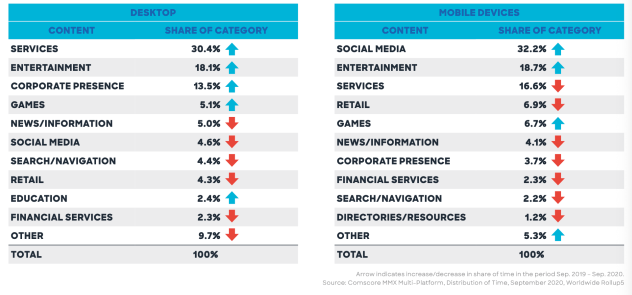
As can be seen from the graph, in the category of desktop devices, the retention times in the categories of "services", "entertainment" and "corporate presence" are the ones that have increased the most, and for this reason computers have been used mainly.
Teleworking from home is one of the consequences of using desktop devices to socialize mobile devices while working, and even as a relaxation space. Most of the time spent on mobiles is related to social media and entertainment, two categories whose weight has increased more than the rest.
This phenomenon simplifies some things to achieve consumer adherence and magnifies known challenges. On the one hand, according to the device used, it is now easier to deduce the context. On the other hand, it is more difficult to control the digital experience from the first moment to the final point, as few apps are today (or what is the same, barrier, filter) access to the digital world.
TREND 4: FROM TRIVIAL/FROM NOTHING TO GLOBAL… IN A FEW WEEKS
Perhaps one of the most striking aspects of the pandemic is the speed of events. Societies and the lives of individuals changed radically in a few days and weeks. Something similar happened online. In the desktop, the teleconference tool Zoom became a priority application for many families, and in the context of work its use was rapidly extended (the popularization of derivative concepts has spread so much: zoombombing, zoom fatigue, etc. ). ). In mobiles, Tik Tok has become the main application of videocreators and the meeting place.
Although the Zoom and Tik Tok applications have occupied the majority of headlines, other services or events have also grown in certain countries. For example, in America (both in North and South America), Zoom and Tik Tok have shown a more receptive attitude towards integrating themselves into their lives. In Europe, for its part, it has focused on news, which has increased the most compared to single users, which has led to greater concern about the impact of the pandemic, taking into account that the logical behaviour spread relatively quickly and strongly in it. In Asia, global companies have been the main winners (users have preferred productivity tools such as Microsoft or Google, such as Youtube).
Of course, both Zoom and Tik Tok are prepandemics. What is new is the speed with which these two companies have spread around the world, so advertisers must now take them into account when preparing their campaigns. Agile and living implementation has long been a slogan for the digital ecosystem, but recent events have reinforced the slogan, which will henceforth be more emphasised than ever: the importance of a brand will depend on its ability to identify new emerging behaviors and adapt to them with a contribution.
TREND 5: MORE CONNECTED TELEVISION… AND MORE DYNAMIC ADVERTISING
Disney+ competed in the war between streaming services at the end of 2019. The year 2020 has brought a new chapter to this war, further increasing the importance of home entertainment. Therefore, video is often the most viral content of marketing campaigns. Platforms like Youtube, Instagram and Tik Tok offer flexibility for experimentation and access to mass audiences. Consequently, video streaming can be placed as a flexible element linking multichannel campaigns.
There is also growing representation in households between traditional and connected television channels: CTVs increase taking into account any device that allows video consumption on the Internet on television. In this sense, advertisers know that video is a phenomenon to be considered for advertising and are getting used to distributing video ads between different platforms.
These five trends summarize the prospecting work of the Comscore agency and, in line with them, the synthesis for advertisers (and a marketing list of interest to the media) can be grouped into the following points:
- Pandemic has accelerated previous trends, such as remote work.
- The diffusion of 5g technology will undoubtedly generate new services and behaviors that will be used and transformed by the entire industry.
- Companies in the right place at the right time will turn their profits timid, as was the case with Zoom in 2020.
- For brands to be able to navigate successfully, they must develop the capacity for constant experimentation, learning and interaction across platforms.
- In this ecosystem it is already known, and the marketing industry has long recognised, the actual measurement of cross-media will become indispensable to value the overall success (cross-media measurement).
- At a time when CTV is blurring the boundaries between platforms and linear television is becoming a digital medium, marketing has a unique opportunity to capitalize on future opportunities guided by the real knowledge of cross-media insights and analytics.
PLAZA DE LA CULTURA DIGITAL
Just as Comscore"s data coincides with the Reuters Institute"s report, annual reflections on digital culture go in a similar direction. “This year, big platforms and social networks have become the dominant, basic ecosystem of human creation” (Carrión, 2020). In his opinion article, published in the New York Times, writer and professor Jorge Carrión reviews the best digital works of 2020, and states that, in the context of the pandemic, the works resulting from classical tradition and the convergence of new languages and tools have multiplied. A new form is therefore consolidated: Cultural objects of high artistic and narrative value capable of seducing many readers and viewers of the Internet. It is firm: ‘It is the consecration of digital culture’.
In the year of the Tik Tok explosion, the aesthetic Zoom and the exponential growth of Netflix have led to the convergence between art and culture on the Internet. Thus, ‘technological acceleration and the temporary suspension of much of analogue programming have made classical culture begin to admit that it will not only have to live with digital, but must be creatively allied with digital’. A new pact in search of the DNA of the digital and the viral and the sharing of the virtues of both worlds.
But what content do we talk about? Instagram history, videos designed for Youtuber, movies and series produced by Netflix/Amazon/others, Spotify playlists, Twitter threads, podcasts, theater and literature via Whatsapp, Filmin festivals… have affected all dimensions this year. And what does that have? Significantly increase the average level of online content.
For Carrión, series and podcasts are new cultural objects based on certain characteristics (and access to them, as with movies or music, is increasingly via the subscription catalogue), while social networks are wider spaces (and therefore more prone to experimentation and surprise). They say that it is not a question of separating the classical from the viral, but of celebrating the hybridations obtained, ‘which will be part of the landscape and the canon of this new normality’. And the media will also have to find their place within that space.
THE BASQUE COUNTRY IS NOT A ISLAND
We are not special, we are not separated, no. Of course, the Basque Country is neither an island nor the Basque media, an exception to the media ecosystem described. Three consecutive graphs illustrating this obvious and known expression. It is impossible (because we do not have data systematically collected) to bring up the international review carried out in this article and therefore to compare ourselves. But we have some data. We have some assurances. For example, we are familiar with the traditional and priority media to report on the current situation of Basque citizenship:

The data collection carried out by Aztiker in 2019, at the request of the HGH research group (Manias, Gurrutxaga, Ramirez de la Piscina, 2020), concluded that the digital press is the traditional media of Basque citizenship, as well as priority. This was (also) before the pandemic.
In 2019, we were digital, what will happen in 2020? Another data collection could confirm the suspicion that the trend would be strengthened if seen in the mirror of international numbers. However, instead of continuing to accumulate suspicions, it would be interesting to activate a systematic collection of this data, as well as a distribution by socio-demographic variables, otherwise hypotheses should continue to be formulated from the hands of others.
But just look at the evolution of digital media audiences for more certainties: The growth of digital media in Basque from the HEKIMEN partnership was marked before the advent of COVID-19, a sector with a low growth rate but continuously growth1, so that when the serious information of the pandemic exploded, the phenomenon accelerated completely (Mimenza, 2020):

The chart above shows the monthly sessions of the HEKIMEN websites in 2020, while the chart below, when compared with the year 2019, clearly shows the jump from the historical peak of April and a significant global increase in 2020:
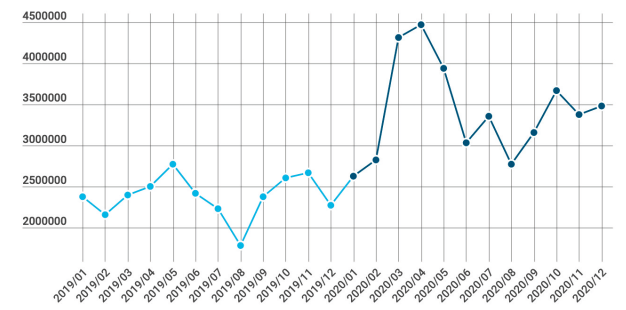
This year’s Yearbook later includes a study on the evolution of the digital audiences of HEKIMEN media, in which the reader will find details of the data and/or the different edges of the phenomenon. The effects of the media ecosystem of the coronavirus pandemic and changes in online (Basque) behaviors have also been studied (Mimenza, Narbaiza and Arana, 2020).
We therefore have some evidence that allows us to observe international trends, but we do not have a proper measurement system for digital audiences at the moment. The definition of indicators and the design and development of a system of its own will be one of the advances to be achieved in the short term. In the Big Data era, our own small data. Let"s start by claiming ownership of data from the very beginning.
And let"s put our feet on the ground, in the present, in the digital.
REFERENCES
Azpilwaukee, Josu and Lizarralde, Mikel (2017): “Analysis of Hekimen website traffic from the Hekimen Analytics tool”, Basque Media Yearbook 2017, p. 81-96, <http://behuntza.eus/txostena/urtekariak/>
Azpilwaukee, Josu and Lizarralde, Mikel (2019): “Analysis of digital audiences of Hekimen 2018 websites”, Basque Media Yearbook 2018, p. 123-140. <http://behuntza.eus/txostena/urtekariak/>
Azpilwaukee, Josu and Lizarralde, Mikel (2020): “Analysis of digital audiences of Hekimen 2019 websites”, Basque Media Yearbook 2019, p. 111-136, <http://behuntza.eus/txostena/urtekariak/>
Azpilwaukee, Josu (2021): ‘Hekimen Web Pages in 2020’, Basque Media Yearbook 2020, p. 121-134,<http://behadera.eus/txostena/urtekariak/>
Carrión, Jorge (2020): ‘2020 enshrines digital culture’, <https://www.nytimes.com/es/2020/12/06/espanol/opinion/lo-mej-2020.html>.
COMSCORE (2020): Global Perspectives: digital and CTV trends to watch in 2021, <https://www.comscore.com/Insights/Present guitar-and-Whitepapers/2020/Globaliz-Digital-and-CTV-trend-to-watch-in-2021>.
HEKIMEN ANALYTICS (d.G. ): <https://analytics .hinici.eus>
Manías, Miren; Gurrutxaga, Guillermo and Ramirez de la Piscina, Txema (2020): “What is the future of the news?”, Basque Media Yearbook 2020, 73-90. p, <http://behuntza.eus/txostena/urtekariak/>.
Mimenza, Libe (2020): « We illustrated ourselves by clicking (Euskera),» Communication in Basque and COVID-19, <http://behuntz.eus/euskaraz -kli-indu-impresion-gara/>.
Mimenza, Libe; Narbaiza, Bea and Arana Edorta (2020): ‘Coronavirus pandemic and online (Basque) behavioural changes in the media ecosystem’, BAT magazine Soziollinguika, 116(3), p. 67-103, <https://bat.soziolinguistika.eus/eu/produktua/116-20203-euskarazko-komunikazioa-2020ko-hamarkadgo-hedabideetan/> <https://bat.soziollinguika .eus/eu/produktion/120203-xliff-newline
REUTERS INSTITUTE (2020): Digital News Report 2020, <https://reutersxliff-newline .politics .ox.ac.uk/sites/default/files/2020-06/DNR_2020_FINAL.pdf>.
STATISTA (2020): “What happens on the Internet in a minute?”, <https://es.statphilo.com/grafico/17539/{{\{\{\}.
1.- Detailed data on the annual web hearings of HEKIMEN websites are available in the Basque Media Yearbooks, in Azpilwaukee and Lizarralde, 2017, 2019 and 2020.


